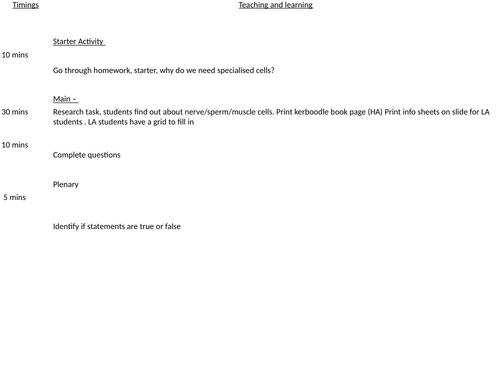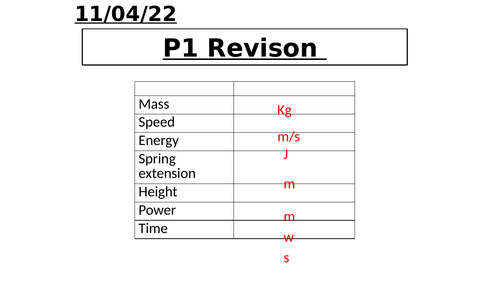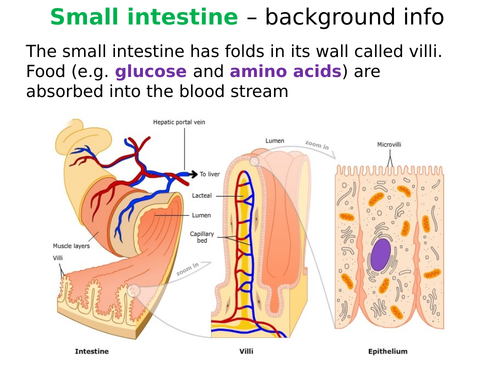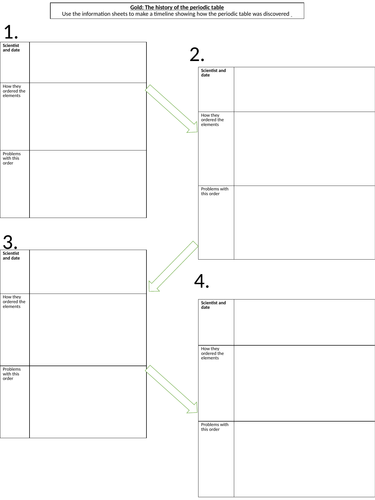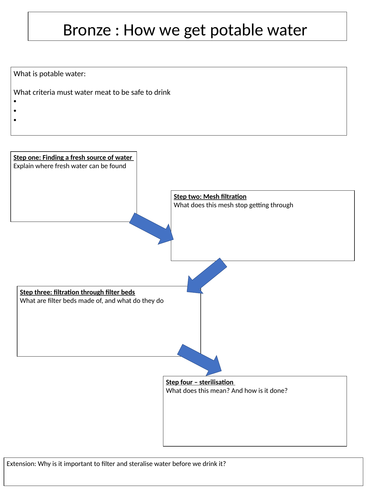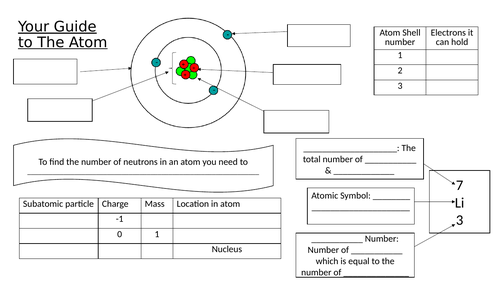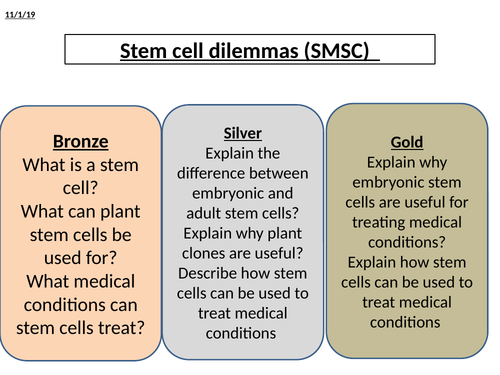
124Uploads
33k+Views
8k+Downloads
All resources

B1.4 Specialised animal cells
Aimed at a mixed ability year 9 class
Starter: why do animals have specialised cells, try and identify cells in the pictures
Main: Research task - using kerboodle books or any other resource, research criteria to meet for each cell.
Lower ability information sheets, and grid to fill in for LA students
Extension: answer questions
Plenary: identify if statements are true/ false

Mixtures
Suitable for KS3
Includes
Recall starter
Element mixture or compound particle diagrams and task
Mini demo or practical to show how we can separate mixtures
Written task to explain how properties can help us separate mixture
Peer assessment grid
recall plenary

Pure and Impure
Suitable for KS3
Includes:
Recall starter
Pure and impure including particle diagrams
Pure and impure boiling points
practical investigation to investigate purity

KS3 investigating solubility
Lesson includes a practical to investigate how temperature affects solubility.
Comes with an optional work sheet.

Elements
Appropriate for KS3
Recall starter, followed by an introduction to elements and particle diagram
Including a mini practical to get students thinking about key properties of elements

B1.10 exchanging materials
Aimed at mixed ability year 9 class
Starter: discuss surface area practical from diffusion lesson
Main: Explain surface area: vol and practice how to work it out
research how different multi cellular animals are adapted
extension: kerboodle checkpoint follow up level 4/6/8
plenary: what have they learnt today

Magnification
Starter: Retrieval starter, based on prior knowledge about animal and plant cells
Main:
explaination of how to convert between common units used in biology
Differentiated task to convert between units
-explaination of how to use standard form
questions to practice on standard form
microscope questions to explain examples
differentiated magnfication worksheet
Plenary:
plenary grid with questions from this lesson and based on animal and plant cells. to be done individually or as a group

Filtering and evaporation KS3
Aimed at mixed ability year 8 - Some resources from TES
L1 - Starter: thinking about what sea water contains
Main: Think pair, share how to separate sea water
introduce key words
write a method/risk assessment for practical
Plenary: particle diagram of what happens during filtering
L2 - Main label equiptment in the diagrams and mark
Main: complete rock salt practical
Differntiated bronze/gold worksheets for students to work their way through
Plenary: one thing students learnt today
Marking sticker provided for the practical, if you wish to level the students work

History of the periodic table KS3
Differentiated retrieval starter questions.
Go through answers
Main –
Add periodic table to key words, watch video about history of periodic table
Using differentiated sheets, create timeline of history of the periodic table
Label modern periodic table and answer questions
Plenary
Carton elements – identify the carton character

Potable water differentiated worksheet
Bronze/silver/gold differentiated worksheets
To show how potable water is made
Aimed at low ability students

C1.6 structure of the atom
aimed at a mixed ability year 9 class
Starter Activity
Put atom structures in the correct order thinking back to last lesson
Main –
Work through work sheet in steps. To ensure maximum understanding
Chase the element – race task to find out what each element around the room is, identifying proton neutron and electron number and matching it with an element on the periodic table
Make a model of an atom using string, and card (cut card into circles use string to attach them together)
Plenary
Tweet what you’ve learnt tday

C11.4 global climate change
Aimed at foundation students targets of level 4
Starter: differentiated bronze/silver/gold starter based on previous lessons in the topic, answers on following slide
Main:
Watch video, write a list of as many problems form global warming
think, pair, share: what is a a carbon footprint - write defintion
discuss what the different countries of the world are trying to do to combat global warming
Students fill in an information sheet from what they have learnt, differentiated extension questions with answers if students complete
Plenary: higher or lower, interactive, do you think the following country has a higher or lower level of renewable energy use

B2.4 stem cell dilemmas
aimed at a mixed ability class
Starter: differentiated starter questions, with answers on following slide
Main: mini debate to start, 6 statemenets rate from 1-5 on 1 being comfortable 5 being completely against.
Students watch video to hear some viewpoints about the use of stem cells. students then are given one statement so they either need to argue for or against stem cell research using their knowledge from the video and from the information sheets
Whole class debate
Finally summarise the points on the board into two columns, one for stem cell research one against stem cell research
Plenary: exam question

B1.10 exchange materials
Aimed at a mixed ability year 9 class
Starter: reflect on previous diffusion practical
Main: explain surface area:vol, do practic equestions and mark
do research task to explain how surfaces are specialised
extension: checkpoint follow ups from kerboodle
Plenary" tweet what theyve learnt

B2 - cell division revision foundation
Revision powerpoint with booklet
for foundation students
Booklet contains activities and information for students to complete

C1.1 atoms
Aimed at a mixed ability year 9 class. Some worksheet from other areas on TES
Starter
Stick in objective sheets for this topic, also stick in common formulae sheets
6 true or false questions – green pen mark
Main –
Think, pair, share – what is an atom? Share ideas, write a sentence to explain what an atoms is. Extension task to label an atoms (level 6 objective) but there is a lesson on the structure of the atom later in this topic
Copy definitions for element/compound/mixture onto worksheet. Then cut up pictures and decide if they are a compound element of mixture
Extension: find the element to spell the cartoon characters worksheet
Identify atoms/elements and name formula worksheet - green pen mark
Extension: write the name of the formulae
Plenary
Whiteboards out, write down the symbol for the elements I shout

C1.2 Chemical equations
Aimed at a mixed ability year 9 class
Worksheets are from TES
Starter Activity
Answer starter questions
Main –
Go through state symbols, make a note of what each means
Explain the conservation of mass – need to write down the defintions
Stretch: why do some reactions appear to gain/lose mass
Go through steps on how to balance equations. Supporting worksheets to build up. Make sure there is an emphasis on what the ‘big’ and ‘little’ numbers mean. Do examples at each step, then get students to complete the rest
Extension sheet of harder equations to balance for students flying through
Plenary
Plenary – make rules for balancing equations

C1.7 Ions, atoms and isotopes
aimed at mixed ability year 9 class
Starter Activity
Differentiated Bronze/silver/gold questions from previous lesson
Main –
Think, pair, share – how big is an atom. Copy down the size of an atom and nucleus intho their books
Copy key words need to be able to define ion and isoptope for level 4
Explain that atoms can lose or gain electrons. And what happens if they do. Students make notes on this, then go through a few examples.
Students practice working out electron/proton/neutron for ions
Extension task for students who finish
Explain what an isotope is, do one worked example of finding proton/neutron numbers then their go at finding how many protons and neutrons are in carbon isotopes
Exam practice if time
Plenary
Identify whether the pictures are atoms, ions or isotopes

